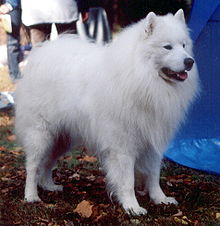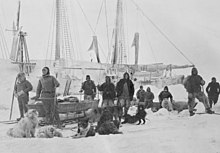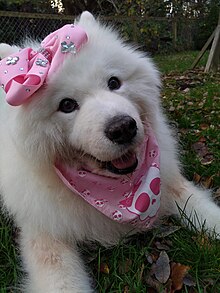Samoyed dog
| Samoyed | |||||||||||||||||||||||||
|---|---|---|---|---|---|---|---|---|---|---|---|---|---|---|---|---|---|---|---|---|---|---|---|---|---|
 | |||||||||||||||||||||||||
| Other names | Bjelkier Samoiedskaya Sobaka | ||||||||||||||||||||||||
| Origin | Russia | ||||||||||||||||||||||||
| |||||||||||||||||||||||||
| |||||||||||||||||||||||||
| Dog ( domestic dog ) | |||||||||||||||||||||||||
The Samoyed (
Samoyed dogs are most often white, and can have a brown tint to their double-layer coat which is naturally dirt-repellent. They are known to be used in expeditions in both Arctic and Antarctic regions and have a friendly and agreeable disposition.
Lineage

The progenitor of the Samoyeds was the

During preparation for the Fram expedition to the North Pole in 1893–1896, 33 dogs were purchased from the Nenets people. While 28 of these dogs would go to the North Pole, none of them survived. The remaining dogs, including pups born during the voyage, were left aboard the ship. In April 1893 the bitch had another litter, most of them white. According to Nansen's notes "...all the dogs were strong, tough and excellent at pulling sleds; they worked very well in hunting Polar bears [as well]." These dogs would become the original Samoyeds.[3][7]
Appearance and characteristics

The
Samoyed eyes are usually black or brown and are almond in shape. Samoyeds with eyes of other colors like blue exist but are not allowed in the show ring. The Samoyed is in the "brown and black section" in its family, the Spitz family.
Samoyed ears are thick and covered with fur, triangular in shape, and erect. They are almost always white but have a light to dark brown tint (known as "biscuit") to a greater or lesser extent. The tint is usually on the ears but can be visible on the whole body.

The Samoyed tail is one of the breed's distinguishing features. Like the Alaskan Malamute, the tail is carried curled over the back; however, unlike the Alaskan Malamute, the Samoyed tail is held actually touching the back. It is not usually held in a tight curl, or held flag-like; it is usually carried lying over the back and to one side. In cold weather, Samoyeds may sleep with their tails over their noses to provide additional warmth. Almost all Samoyeds will allow their tails to fall when they are relaxed and at ease, as when being stroked or while eating, but will return their tails to a curl when more alert.
Samoyeds have a dense,
Shed Samoyed fur is sometimes used as an alternative to wool in knitting, with a texture similar to angora. The fur is sometimes also used for the creation of artificial flies for fly fishing.
Life expectancy for the breed is about 12–13 years.[10]
Temperament

Samoyeds' friendly and affable disposition makes them poor guard dogs; an aggressive Samoyed is rare. The breed is characterized by an alert and happy expression which has earned the nicknames "Sammie smile" and "smiley dog".[11] With their tendency to bark, however, they can be diligent watch dogs, barking whenever something approaches their territory. Samoyeds are excellent companions, especially for small children or even other dogs, and they remain playful into old age. According to the Samoyed Club of America, when Samoyeds become bored, they may become destructive or start to dig.[12]
Activities

Samoyeds can compete in
Health
Samoyed hereditary glomerulopathy
The breed can be affected by a genetic disease known as Samoyed hereditary glomerulopathy, a

Carrier females do develop mild symptoms after 2–3 months of age, but mostly
Clinically,
If a carrier female is mated with a healthy
Other health concerns
For the Samoyeds several breed-specific hereditary diseases are described in the veterinary literature:
- Progressive retinal atrophy (PRA) caused by a frameshift mutation in the RPRG locus of the X chromosome. The disease leads to a slowly progressive loss of vision, which eventually leads to blindness. The first symptoms appear between two and five years of age. The disease corresponds to the X-linked PRA type 3 in humans.[22][23]
- Short legs in conjunction with eye abnormalities: a genetic defect at the COL2A1 locus leads to disproportionate dwarfism due to short limbs in connection with cataracts, malformations of the retina and / or retinal detachment, liquefaction of the vitreous and a persistent hyaloid artery. The malformations of the retina are dominant (i.e. they occur in heterozygous dogs); the other symptoms are recessive, so they only come to expression in homozygous dogs. These conditions have no effect on the expression of the protein opticin.[24][25][26]
- Pulmonary stenosis occurs more frequently in Samoyeds in comparison with other breeds. The disease can cause shortness of breath, cardiac arrhythmias and rapid fatigue when moving, and increases the risk of congestive heart failure.[27]
- Hip dysplasia is also a concern for Samoyeds.[28]
- The breed can also be affected by idiopathic autoimmune skin disease.[29]
See also
- Samoyeds
- List of dog breeds
References
- ^ Student Dictionary. "Samoyed". World Central. Merriam-Webster Incorporated. Archived from the original on 2 February 2018. Retrieved 2 February 2018.
- ^ "Давай-ка, ненецкая лайка!". kras.mk.ru (in Russian). 20 December 2017. Retrieved 13 February 2022.
- ^ a b Presberg, Carole (2014). "Herding Dogs of Asia: Russian Siberia". www.bordercolliemuseum.org. Retrieved 13 February 2022.
- ISSN 1548-1433.
- PMID 22615366.
- S2CID 237584023.
- ^ "The Samoyed: Breed Origin and History". samoyedclubofamerica.org.
- ^ "Samoyed". AKC.
- ^ Bakalar, Nicholas (11 July 2011). "The Myth of the Allergy-Free Dog". The New York Times. Retrieved 18 July 2015.
- ^ "Individual Breed Results for Purebred Dog Health Survey". TheKennelClub.org.uk. Archived from the original on 13 August 2013. Retrieved 26 June 2012.
- ^ "AKC Meet the Breeds: Samoyed". American Kennel Club. Archived from the original on 11 January 2013. Retrieved 8 October 2011.
- ^ "Bad Habits and Training".
- ISBN 978-1-57779-106-5.[page needed]
- ^ PMID 3711721.
- PMID 11380016.
- PMID 8171024.
- PMID 9447482.
- PMID 12595505.
- ^ "Samoyed Hereditary Glomerulopathy". vetgen.com. Veterinary Genetic Services. Retrieved 3 February 2013.
- PMID 12022409.
- PMID 17611256.
- PMID 7366567.)
{{cite journal}}: CS1 maint: numeric names: authors list (link - PMID 17646274.
- PMID 12002589.
- ^ Acland, Gregory M. (1991). "Retinal dysplasia in the Samoyed dog is the heterozygous phenotype of the gene (drds) for short limbed dwarfism and ocular defects". Transactions of the American College of Veterinary Ophthalmology. 22: 44.
- PMID 11814684.
- PMID 6749116.
- PMID 7459792.
- .
Further reading
- Bernard, MA; Valli, VE (1977). "Familial renal disease in Samoyed dogs". The Canadian Veterinary Journal. 18 (7): 181–9. PMID 884645.
- Meyers, VN; Jezyk, PF; Aguirre, GD; Patterson, DF (1983). "Short-limbed dwarfism and ocular defects in the Samoyed dog". Journal of the American Veterinary Medical Association. 183 (9): 975–9. PMID 12002589.
- Kimmel, SE; Ward, CR; Henthorn, PS; Hess, RS (2002). "Familial insulin-dependent diabetes mellitus in Samoyed dogs". PMID 12022409.
External links
- Samoyed dog at Curlie
